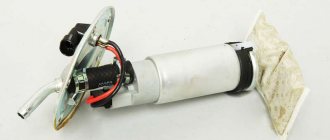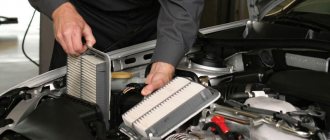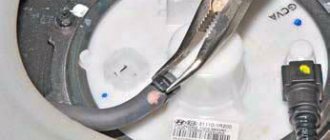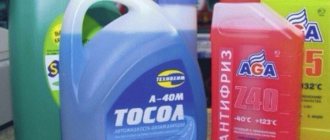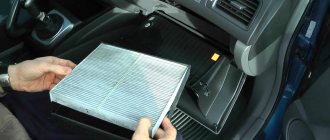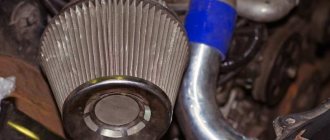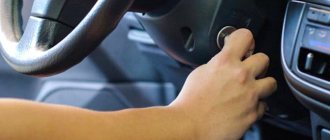Almost all internal combustion engines are equipped with filters to clean the fuel before entering the cylinders. They trap foreign particles whose size exceeds the pore diameter. Fuel contaminants include clay fragments, sand, paint chips, rust particles of various sizes, or random debris.
Manufacturers cannot be blamed for their getting into the fuel, since at refineries, before sending to the distribution network, any fuel is carefully filtered. The source of contamination most often is tanks, containers and canisters, into which it is repeatedly pumped before the liquid is poured into the tank.
Whenever the container is filled with fuel, sediment rises from its bottom, which previously lay below the outlet neck. The same shaking occurs when transporting the tank to a gas station or discharge point. Thus, unsettled contaminants end up in car tanks.
How does a fuel filter work?
Fuel filtration on modern cars is two-stage. In front of the fuel pump, a fine nylon receiving mesh screens out contaminant particles. And then the final screening of particles larger than 10 microns (for gasoline) is carried out by a fine filter.
The fuel module of the Lada 4x4 consists of a mesh fuel receiver and a fuel pump.
The fuel module of the Lada 4x4 consists of a mesh fuel receiver and a fuel pump.
Video “Visual instructions for replacing the filter”
Using the Ford Focus car as an example, the Service Guide channel offers to familiarize yourself with the procedure for changing the filter device.
Do you have any questions? Specialists and readers of the AUTODVIG website will help you ask a question
Was this article helpful?
Thank you for your opinion!
The article was useful. Please share the information with your friends.
Yes (100.00%)
No
X
Please write what is wrong and leave recommendations on the article
Cancel reply
Rate this article: ( 2 votes, average: 5.00 out of 5)
Discuss the article:
Where is the fuel filter installed?
As for the location of the fine filter, automakers' opinions have changed over time. In the beginning, all filters were installed under the car's underbody or in the engine compartment and were easily accessible for replacement.
Fuel filter under the bottom of the car with threaded ends. |
The plastic fuel filter is connected to the power system with quick-release tips. |
Then (increasingly) the filter began to be installed in the fuel module. This solution is, of course, more compact and convenient for cars. But replacing the filter is either not provided at all, but only as part of the module, or it involves a large amount of work to dismantle and completely disassemble the module. Moreover, the fuel module of some cars cannot be removed without dismantling the tank, and this is an even more ambitious task.
Fuel module with built-in filter. |
After completely disassembling the module, it is possible to remove and replace the fuel filter. |
Signs of a blockage
Does a car enthusiast need to know when to change the filter? A number of features are known for this purpose. All symptoms are caused by poor fuel supply.
We provide the main signs of a fuel filter failure:
- Severely reduced power;
- Uneven engine operation - often detected by sneezing or jerking of the car;
- Increased fuel consumption. This sign is indirect, it is not always connected with this.
In the first stages of blockage, these signs of blockage are not clearly expressed, so drivers do not notice alarm bells.
Only after the fuel supply has completely stopped do the owners begin to think about the reason. There are cases when the car did not start due to the fact that gasoline could not squeeze through the filter.
Diesel fuel filter
So far we have been talking about gasoline filters. Diesel fuel filters are always installed separately from the fuel tank, because, in addition to more frequent replacement, they also need water sensors, a water drain plug and, often, a heating system.
Fuel filters for diesel engines.
Fuel filters for diesel engines.
Fuel system types
Car fuel system diagram
To understand when it is necessary to change the filter device on a gasoline or diesel engine, you need to understand the types of fuel systems:
- Carburetor. These engines run on gasoline. Carburetor systems are considered obsolete and are one of the most complex in design. The purpose of the carburetor is to prepare the air-fuel mixture for the power unit. Carburetor systems have many subsystems that ensure this function is performed in different operating modes of the internal combustion engine. Despite all the disadvantages, such engines also have advantages. For example, low repair costs due to inexpensive fuel equipment components. Carburetor engines do not require the installation of high pressure pumps. The disadvantages are usually associated with ICE maintenance. Carburetor engines require constant maintenance. In the cold season, the engine must be configured correctly so that it can start without problems at low negative temperatures.
- Mono-injection. They are considered more modern systems, characterized by the presence of monophonic injection. Instead of a carburetor, it uses a spray device equipped with a single nozzle. Fuel atomization occurs when the power unit sucks in air currents. Mono-injection power systems are installed on engines running on gasoline. For optimal operation of the unit, a high pressure fuel pump and a return line are required. The system is also equipped with an engine control unit, which is used for the correct dosage of gasoline. The control module receives data from sensors of mass air flow, fuel pressure and others, as a result of which it configures the internal combustion engine for correct operation. Thanks to the use of monophonic injection, the design itself is more expensive compared to carburetor systems, but the unit starts easier at cold temperatures and is generally more stable. This allows you to reduce financial maintenance costs.
- Injection power systems with distributed injection. A more advanced engine option. Multipoint or distributor injection can be used. In such versions, the main shortcomings characteristic of older injection systems were corrected. Each cylinder of the power unit is equipped with injectors. In general, injectors have a similar principle of operation to the systems described above, but such engines are considered more environmentally friendly. Thanks to modernization, the designers managed to achieve stable operation of the unit and reduce fuel consumption; the cost of the systems was also increased.
- Injection internal combustion engines with direct injection. This type is considered one of the most perfect. In such engines, the process of atomizing the air-fuel mixture is carried out using nozzles mounted on each cylinder of the engine. Thanks to this, fuel consumption was reduced by 20% compared to systems with distributor injection. The designers were able to increase the technical parameters of the unit, including its power. The main disadvantage of such a system is its high cost, high demands on operation and the quality of the fuel being poured, as well as dependence on the use of different pumping devices. This is not just about the high pressure fuel pump.
- Diesel systems with a multi-section plunger pump. In it, fuel injection is carried out at the moment when the pump section delivers a portion of fuel. The pump itself is driven by the crank shaft. Such systems are not so demanding on the quality of the diesel fuel used, its cost is generally lower, but it is not as environmentally friendly. These systems are not equipped with a turbocharger, which can be attributed to disadvantages.
- Diesel systems with pump injectors. The advantages of improved engines include practicality and more reliable engine operation. If one of the cylinders breaks down, other devices continue to operate as usual. Each injector is equipped with its own pump, which makes it possible not to use overly long high-pressure fuel drives. But the cost of injectors is quite high, and these elements are classified as consumables, so they are also changed at certain intervals when they reach the end of their service life. Such systems are demanding on the quality of the fuel used.
- Common Rail. Such power systems are considered the most advanced; their use involves the use of a common ramp. The operating principle is similar to direct injection vehicles using gasoline. Common Rail power systems imply the presence of an electric high-pressure pumping device, with the help of which a pressure above 200 atmospheres is created in the lines. Electrical impulses supplied from the engine control unit open the injectors. The main advantages of the system include the high efficiency of the unit, reduced fuel consumption and a minimum amount of harmful substances in the exhaust gases, which makes the engines environmentally friendly. The disadvantages include the demands of engines on the quality of diesel fuel.
The ural biker channel showed how to change the fuel filter device in a Nissan Qashqai.
What happens if the fuel filter is clogged?
The filters are, of course, damaged by the dirt that gets into the tanks of our cars along with the fuel. And it’s not the oil refineries that are to blame. Fuel can become contaminated during storage and transfer. And the driver will feel the clogging of the fuel filter by the behavior of the car, and first in those modes where the instantaneous fuel consumption of the engine is maximum. These are driving modes at high speeds and intense acceleration. In this case, the engine will lose traction and operate intermittently, although at idle and in “quiet” modes everything will look decent.
Causes of malfunctions
In what cases is it necessary to change the filter element:
- If it becomes clogged and has expired its service life.
- If the power system was repaired, and during the process some of its components were removed.
- If dirt and other foreign substances, for example, additives, have entered the gas tank and have a negative impact on the operation of the power unit. When the fuel lines are washed, a new filter must be installed.
- As a preventive measure before a long trip over a long distance.
- If you have been refueling with low-quality fuel for a long time, which has led to problems with the engine.
Find out what the filter device looks like in cross-section after 10 thousand km of run from the video filmed by the TEXaS TV channel.
How often should the fuel filter be changed?
The frequency of routine filter replacement is primarily determined by the vehicle manufacturer. For some manufacturers this is 30,000 km, for others - 120,000 km. Moreover, frequent replacements are usually recommended by manufacturers who place the filter outside the fuel tank. You should only change the fuel filter ahead of schedule if you are sure that foreign mechanical particles or a large amount of water have entered the tank. In this case, you should also rinse the tank and possibly replace the fuel pump.
Diesel engine fuel filters have the most difficult time in winter: after all, thickened fuel must pass through the filter material. That is why it is better to carry out preventive filter replacement on a diesel car in the fall. This is due to the fact that the filter capacity, already reduced by clogging with solid particles, will be insufficient to pass the cold, thickened fuel.
Frequency of replacement of gasoline filters of some manufacturers, thousand km:
- Volkswagen 30 (remote filters)
- Renault 120
- Kia 60
- Hyundai 60
- Lada 30 (remote filters), 120 (built-in filters)
Some tips for replacing the fuel filter:
- Refuel at proven, or even better, branded gas stations.
- Try not to pour fuel into the tank immediately after the fuel has been drained from the tanker at a gas station, because the fuel in the tank is agitated and dirt is more likely to get in.
- Do not pour fuel into old, rusty cans.
- Change fuel filters on time - then a malfunction will not catch you on a long journey.
- Wash the fuel intake strainer at the pump inlet: this will extend its service life.
Tell us in the comments if you have encountered problems related to fuel filters? Good luck on the roads everyone!
Fuel filter: should I change it or will it do the same?
How does the replacement take place?
The fuel filter is replaced in the following order:
- On a car with carburetors, just unscrew the clamps and pull the hoses out of the fittings, then unscrew the consumable body and replace it with a new product.
- On machines with fuel supply from an injector, these actions must be carried out from the inspection hole or lying under the bottom.
- On the diesel version, you need to pull out the tubes, remove the cover and remove the littered paper insert.
The location of the filter and the replacement method may differ depending on the make and model of the vehicle.
For example, on a gasoline car, instead of a round barrel that cannot be disassembled, a housing with a filter paper insert can be installed. In this case, this core changes. When you need to clean or change the screen in the tank, then you need to remove the gasoline pump.
Why in winter?
Harmful effects of paraffin on the filtration element
In winter, at a certain temperature, paraffin is formed in low-quality diesel fuel, which can clog the fuel filter. Therefore, experienced drivers carry a spare filter device if the car is operated in a region with a temperature of -200C or lower. In this case, if the filter becomes clogged, it can be replaced with another one.
There are drivers who prefer to install heated filters or use “antigel”. When heating the fuel liquid, paraffin does not crystallize, and there is no need to carry an additional filtration element with you. The use of special liquids that prevent the formation of paraffin crystals also solves the problem of unscheduled filter replacement due to low temperatures.
Based on all of the above, we can conclude: the filter device of a diesel car must be changed according to the recommendations of the car manufacturer, and not only when low temperatures occur.
